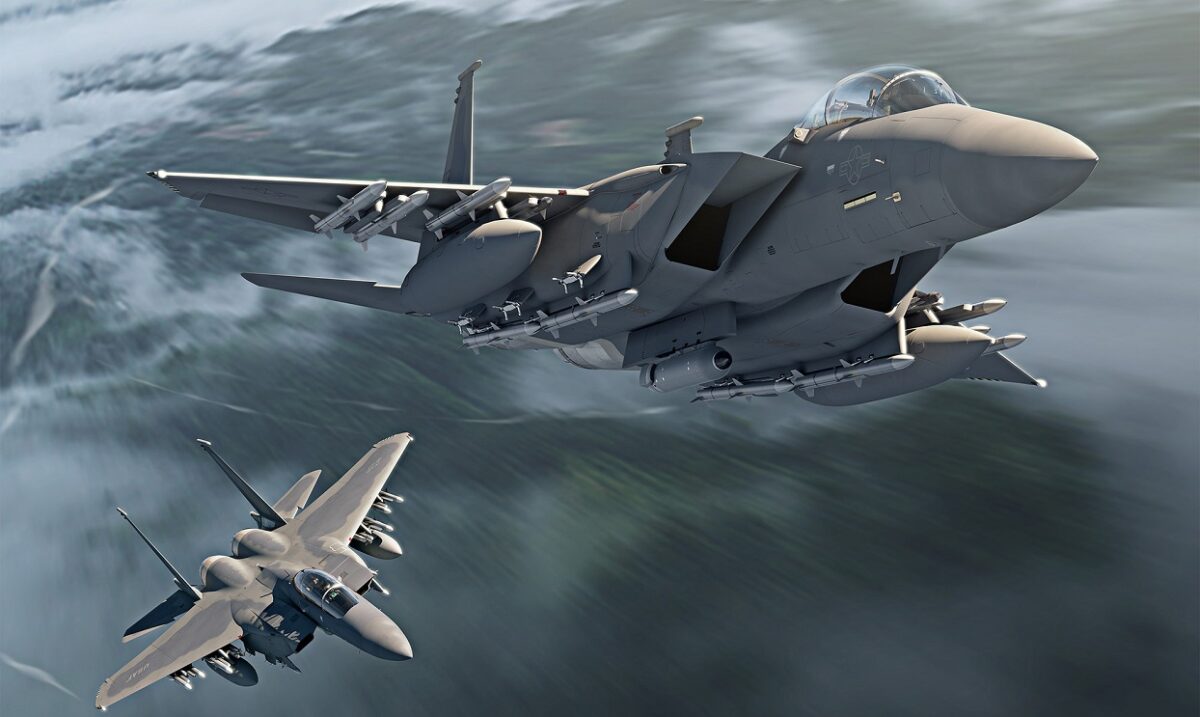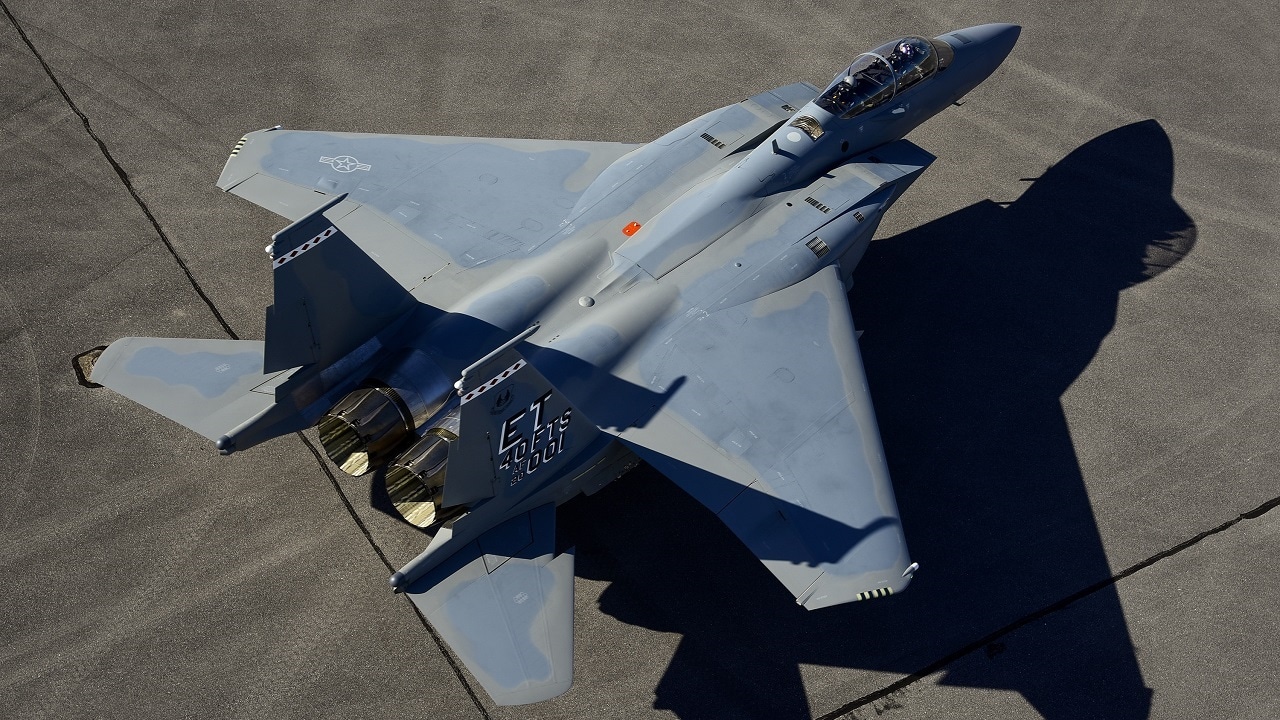The F-15EX Keeps Pumping Out New and Exciting Technology: As fans of the Top Gun film series certainly know, learning to be a modern fighter pilot comes with some risks. While many pilots will hone their skills with flight simulators on the ground, but the technology certainly has its limitations – and even the most advanced hardware-based aids fail to replicate what one experiences in an actual cockpit.
This is where the latest augmented reality (AR) technology could be seen as a significant leap forward. Soon pilots in the cockpit of an F-15EX will be able to engage with adversaries that look and react entirely real but aren’t actually there.
Combat Simulators for F-15EX – Augmented Not Virtual Reality
Flight simulators aren’t exactly new, and since the original Link Trainer was developed in 1929 by Edwin Albert Link of Binghamton, NY, such tools have been used to help train pilots. Link’s original design actually incorporated pumps, valves, and bellows to mimic what a pilot might experience – and his trainers proved crucial for training American pilots during the Second World War.
The technology has only steadily improved in the decades since, and in recent years the U.S. military has adopted virtual reality (VR) technologies to enhance what warfighters face during training. This has included extremely immersing VR-based simulations for pilots.
However, though VR has its benefits, one area where it still falls short is in training fighter pilots. The technology can create a realistic environment for level flying and teach trainees to use the controls, yet it still lacks key aspects that simply can’t be simulated. This is where AR comes into play.
Red 6’s Airborne Tactical Augmented Reality System (ATARS) can bridge the gap from the fully virtual to the physical reality of the world. Its system was developed as part of the United States Air Force’s tech incubator, AFWERX, which awarded the Santa Monica, California-based company a $1.5 million development grant to create a combat training system that utilized augmented reality (AR) rather than pure VR.
AR in the F-15EX
This month the AR software company announced a collaboration with aerospace giant Boeing to develop leading-edge aerial dogfighting technology and training in advanced tactical aircraft. Boeing has now become the first company to team with Red 6 on this type of advanced training technology.
The joint agreement could be the first step toward future integration of Red 6’s Advanced Tactical Augmented Reality System (ATARS) and Augmented Reality Command and Analytic Data Environment (ARCADE) into Boeing-manufactured next-generation aircraft. The T-7 Red Hawk trainer and F-15EX fighter platforms will be among the first to receive ATARS and ARCADE.
According to Red 6, aircraft equipped with the ATARS will enable pilots to “see and interact” with augmented reality aircraft, targets, and threats on the ground or in the air while flying and training in their actual aircraft. This has the promise to reduce the cost of and need for multiple platforms used in real-world training exercises.
“We continue to revolutionize the way we train and fight. Red 6’s Augmented Reality system with the pathfinding T-7 and the F-15EX represents another transformational leap in capability. This agreement is the latest example of Boeing’s commitment to investing in technology and our drive to lead innovation in the aerospace and defense sectors,” said Dan Gillian, vice president and general manager of U.S. Government Services for Boeing Global Services.
In addition, the ATARS enables a multitude of tactical training scenarios delivered through AR. These include air combat maneuvers, refueling, tactical formation, and surface-to-air weapon engagements. ARCADE will further increase the efficiency of mission planning, briefing, and debriefing through real-time 3D visualizations to construct and re-construct sorties.
“Readiness and lethality are critical if our warfighters are to prevail against peer adversaries,” added said Daniel Robinson, founder and CEO of Red 6. “Boeing’s next-generation platforms will be the first aircraft in the world that are capable of entering our augmented reality training environment. Together, we will deliver a paradigm shift in the quality, quantity, and cost of training future pilots.”
The F-15EX Flying High
The Boeing F-15EX could be well-suited to this new technology. The two-seat multirole fighter is a greatly enhanced and upgraded aircraft based on the McDonnell Douglas F-15 Eagle, which first entered service back in 1976, just months before the United States bicentennial celebrations. The twin-engine, all-weather tactical F-15 has had one of the most successful track records of modern fighters, with more than 100 victories and no losses in aerial combat. The aircraft’s design also proved flexible enough that an improved all-weather strike derivative, the F-15E Strike Eagle, was later developed and entered service in 1989.

Two Boeing F-15EX fighters armed with air-to-air missiles. Boeing handout.
Externally the aircraft may resemble the original F-15, but it is a far more advanced aircraft. It features fly-by-wire flight controls, new weapons stations, a new electronic warfare suite, advanced radar and computer, conformal fuel tanks, and a strengthened airframe. In addition, the improved F-15EX is further equipped with a deep magazine that will allow it to carry a number of advanced weapons – yet with a 28 percent larger payload than the F-15E.
At the same time, the fighter will also require only minimal transitional training and little additional manpower from the older versions of the F-15. It will also soon allow pilots to use AR in training.

